| Capparis | |
|---|---|
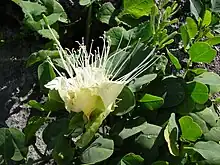 | |
| Maiapilo (Capparis sandwichiana) | |
| Scientific classification | |
| Kingdom: | Plantae |
| Clade: | Tracheophytes |
| Clade: | Angiosperms |
| Clade: | Eudicots |
| Clade: | Rosids |
| Order: | Brassicales |
| Family: | Capparaceae |
| Tribe: | Cappareae |
| Genus: | Capparis L. (1753)[1] |
| Species[2] | |
|
142, see text | |
| Synonyms[2] | |
| |

Capparis is a genus of flowering plants in the family Capparaceae.[3] It includes 142 species[2] of shrubs or lianas which are collectively known as caper shrubs or caperbushes. Capparis species occur over a wide range of habitat in the subtropical and tropical regions of Africa, Eurasia, Australasia, and the Pacific.[2]
The genus was included in the family Brassicaceae in the unrevised APG II system.
Plant description
The leaves are simple, entire, and rarely reduced. Flowers are bisexual, bracteates, axillary or supra-axillary, solitary or in rows, in racemes or umbels. Sepals and petals are 4 in number and are free. Stamens are many, ovary on a gynophore, one-celled. Fruit is a berry, globose or ellipsoid.[4]
Uses and ecology
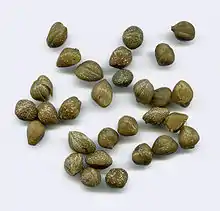
Caperbushes are mainly used by humans for their fruit, which are rich in micronutrients. C. spinosa, simply known as caper, yields fruit and more importantly flower buds, which are widely used pickled as a vegetable condiment. The fruit of other species, such as karir (C. decidua), are also used for cooking; C. mitchellii and the Wild passionfruit (the local subspecies of C. spinosa) are well-known bush tucker in Australia. Mabinlang seeds (C. masaikai) are eaten as sweets.
Mabinlang is also used in Traditional Chinese Medicine. Aspalathos, the root of a shrub contained for example in the sacred Ancient Egyptian incense kp.t (kyphi), is sometimes considered to be C. spinosa. Other species have also recorded uses in herbalism and folk medicine; dedicated research is largely lacking however. Mabinlins are sweet-tasting proteins found in Mabinlang seed (and possibly in other Capparis species); at least one of them is highly resistant to heat. The market for mabinlins is not large, but this is mainly due to insufficient supply rather than to lack of demand.
The 1889 book The Useful Native Plants of Australia records that Capparis canescens was also referred to as "Mondoleu" by the indigenous people from Rockhampton area of Queensland and that "The fruit is pyriform and half an inch in diameter. It is eaten by the aborigines without any preparation." (Thozet.) Mr. P. O'Shanesy observes that the pulpy part in which these Australian species of Capparis are imbedded is a good substitute for mustard."[5]
Caperbushes from arid regions - chiefly C. decidua - are highly useful in landscape gardening, afforestation and reforestation. They can stop soil erosion and preserve agricultural land. Any large-flowered species can be used to attract butterflies. The Crimson Rose (Atrophaneura hector), a spectacular swallowtail butterfly of South Asia, likes to visit flowers of C. spinosa in the winter months for example.
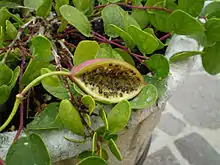
The fruit and seeds of caperbushes are relished by many birds and other animals such as spiny-tailed lizards. Capparis plants are highly important as food for certain Lepidoptera caterpillars, many of them being Pierinae:
- Appias lyncida (chocolate albatross) - recorded on C. heyneana and C. roxburghii.
- Astraptes fulgerator (two-barred flasher) - recorded on C. frondosa.[6]
- Belenois aurota (caper white or pioneer) - recorded on C. zeylanica.
- Cepora nerissa (common gull) - mainly on C. zeylanica.
- Hebomoia glaucippe (great orangetip) - recorded on C. monii, C. roxburghii and C. sepiaria.
- Ixias marianne (white orangetip) - recorded on C. grandis, C. sepiaria, C. decidua, and C. divaricata.[7][8]
- Leptosia nina (psyche) - recorded on C. zeylanica and others.
- Pareronia ceylanica (dark wanderer) - recorded on C. heydeana,[9] C. rheedii[7]
- Pareronia valeria (common wanderer) - recorded on C. zeylanica, C. rheedii,[7] C. heydeana[9]
The plant pathogenic ascomycete fungus Mycosphaerella capparis was described from a caperbush. Some species of Capparis are becoming rare, mainly due to habitat destruction, and a few are seriously threatened with extinction.
Species
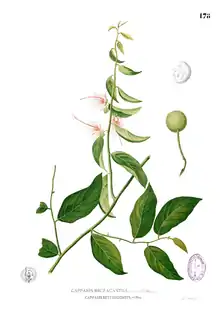
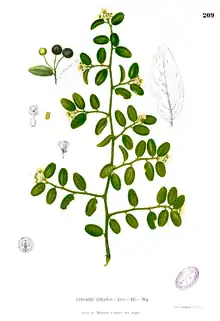
Plants of the World Online currently includes:[2]
- Capparis acutifolia Sweet
- Capparis annamensis (Baker f.) M.Jacobs
- Capparis anomala (F.Muell.) Christenh. & Byng
- Capparis arborea (F.Muell.) Maiden – Brush caper
- Capparis artensis Montrouz.
- Capparis assamica Hook.f. & Thomson
- Capparis bachii Sy, R.K.Choudhary & Joongku Lee
- Capparis batianoffii Guymer
- Capparis beneolens Gagnep.
- Capparis bodinieri H.Lév.
- Capparis brachybotrya Hallier f.
- Capparis brassii DC.
- Capparis brevispina DC.
- Capparis burmanica Collett & Hemsl.
- Capparis buwaldae M.Jacobs
- Capparis callophylla Blume
- Capparis canescens Banks ex DC.
- Capparis cantoniensis Lour.
- Capparis cartilaginea Decne.
- Capparis cataphyllosa M.Jacobs
- Capparis chingiana B.S.Sun
- Capparis chrysomeia Bojer
- Capparis cinerea M.Jacobs
- Capparis cleghornii Dunn
- Capparis corymbosa Lam.
- Capparis cucurbitina King
- Capparis daknongensis Sy, G.C.Tucker, Cornejo & Joongku Lee
- Capparis danielii Murugan, R.Manik., S.P.Nithya, B.Karthik & Arisdason
- Capparis dasyphylla Merr. & F.P.Metcalf
- Capparis decidua (Forssk.) Edgew. (= C. aphylla) – karir (kirir, k(h)air, karril, etc.)
- Capparis diffusa Ridl.
- Capparis dioica Gilg
- Capparis divaricata Lam.
- Capparis diversifolia Wight & Arn.
- Capparis dongvanensis Sy, B.H.Quang & D.V.Hai
- Capparis echinocarpa Pierre ex Gagnep.
- Capparis erycibe Hallier f.
- Capparis erythrocarpos Isert
- Capparis fascicularis DC.
- Capparis fengii B.S.Sun
- Capparis flavicans Kurz
- Capparis floribunda Wight
- Capparis florida Fici & Souvann.
- Capparis fohaiensis B.S.Sun
- Capparis formosana Hemsl.
- Capparis fusifera Dunn
- Capparis gialaiensis Sy
- Capparis grandidieri Baill.
- Capparis grandiflora Wall. ex Hook.f. & Thomson
- Capparis grandis L.f.
- Capparis hainanensis Oliv.
- Capparis henryi Matsum.
- Capparis hereroensis Schinz
- Capparis heteracantha DC.
- Capparis hinnamnoensis Souvann. & Fici
- Capparis humistrata (F.Muell.) F.Muell.
- Capparis hypovellerea Gilg & Gilg-Ben.
- Capparis incanescens DC.
- Capparis irenae Fici
- Capparis jacobsii Hewson
- Capparis kbangensis Sy & D.V.Hai
- Capparis kebarensis Fici
- Capparis khuamak Gagnep.
- Capparis klossii Ridl.
- Capparis koioides M.Jacobs
- Capparis kollimalayana M.B.Viswan.
- Capparis lanceolaris DC.
- Capparis lanceolatifolia Fici, Bouaman. & Souvann.
- Capparis laotica Gagnep.
- Capparis lasiantha R.Br. ex DC.
- Capparis lianosa Fici & Souvann.
- Capparis lobbiana Turcz.
- Capparis longestipitata Heine
- Capparis longgangensis S.L.Mo & X.S.Lee ex Y.S.Huang
- Capparis loranthifolia Lindl.
- Capparis lucida (Banks ex DC.) Benth.
- Capparis macleishii (A.G.Mill.) Christenh. & Byng
- Capparis macrantha Souvann., Fici & Lanors.
- Capparis masaikai H.Lév.
- Capparis mekongensis Gagnep.
- Capparis membranifolia Kurz
- Capparis micracantha DC.
- Capparis micrantha A.Rich.
- Capparis mitchellii (Lindl. ex F.Muell.) Lindl. – wild orange (Australia), merne atwakeye (Arrernte)
- Capparis monantha M.Jacobs
- Capparis moonii Wight
- Capparis multiflora Hook.f. & Thomson
- Capparis nilgiriensis Subba Rao, Kumari & V.Chandras.
- Capparis nobilis (Endl.) F.Muell. ex Benth. - devil's guts (Norfolk Island)
- Capparis nummularia DC.
- Capparis olacifolia Hook.f. & Thomson
- Capparis ornans F.Muell. ex Benth.
- Capparis pachyphylla M.Jacobs
- Capparis parvifolia Fici
- Capparis poggei Pax
- Capparis pranensis (Pierre ex Gagnep.) M.Jacobs
- Capparis pseudocerasifera Hauman
- Capparis pubiflora DC.
- Capparis pubifolia B.S.Sun
- Capparis pyrifolia Lam.
- Capparis quiniflora DC.
- Capparis radula Gagnep.
- Capparis ramonensis Danin
- Capparis rheedei DC.
- Capparis richardii Baill.
- Capparis rigida M.Jacobs
- Capparis rotundifolia Rottler
- Capparis roxburghii DC.
- Capparis rufidula M.Jacobs
- Capparis sabiifolia Hook.f. & Thomson
- Capparis sandwichiana DC. – Hawaiian caper,[10] Maiapilo, Pua pilo (Hawaiʻi endemic)[11]
- Capparis sarmentosa A.Cunn. ex Benth.
- Capparis scortechinii King
- Capparis sepiaria L.; a cryptic species complex
- Capparis shanesiana F.Muell.
- Capparis shevaroyensis Sundararagh.
- Capparis siamensis Kurz
- Capparis sikkimensis Kurz
- Capparis spinosa L. – Caper
(note: C. zoharyi Inocencio, D.Rivera, Obón & Alcaraz is a synonym of C. spinosa var. aegyptia (Lam.) Boiss.) - Capparis srilankensis Sundararagh.
- Capparis subsessilis B.S.Sun
- Capparis sunbisiniana M.L.Zhang & G.C.Tucker
- Capparis tagbanuorum Fici
- Capparis tchaourembensis Fici
- Capparis tenera Dalzell
- Capparis thorelii Gagnep.
- Capparis thozetiana (F.Muell.) F.Muell.
- Capparis tomentosa Lam.
- Capparis tonkinensis Gagnep.
- Capparis trichocarpa B.S.Sun
- Capparis trinervia Hook.f. & Thomson
- Capparis trisonthiae Srisanga & Chayam.
- Capparis umbonata Lindl. - northern wild orange
- Capparis urophylla F.Chun
- Capparis velutina P.I.Forst.
- Capparis versicolor Griff.
- Capparis viburnifolia Gagnep.
- Capparis viminea Oliv.
- Capparis wui B.S.Sun
- Capparis yunnanensis Craib & W.W.Sm.
- Capparis zeylanica L. (= C. linearis Blanco) – kapchip (Wayuunaiki)[12][13]
- Capparis zippeliana Miq.
- Capparis zoharyi Inocencio et al.
Formerly placed here
- Adansonia gregorii F.Muell. (as Capparis gibbosa A.Cunn.)
- Boscia albitrunca (Burch.) Gilg & Benedict (as C. albitrunca Burch.)
- Boscia oleoides (Burch. ex DC.) Toelken (as C. oleoides Burch. ex DC.)
- Crateva magna (Lour.) DC. (as C. magna Lour.)
- Morisonia flexuosa L. (as C. flexuosa (L.) L.) – Limber caper
- Morisonia hastata (Jacq.) Christenh. & Byng (as C. hastata – Broadleaf caper
- Morisonia heterophylla (Ruiz & Pav. ex DC.) Christenh. & Byng (as C. heterophylla Ruiz & Pav. ex DC.)
- Morisonia pulcherrima (Jacq.) Miers (as C. pulcherrima Jacq.)
- Morisonia retusa (Griseb.) Christenh. & Byng (as C. retusa Griseb.)
- Morisonia salicifolia (Griseb.) Christenh. & Byng (as C. salicifolia Griseb.)[13]
- Morisonia scabrida (Kunth) Seem. (as C. scabrida Kunth)
- Morisonia speciosa (Griseb.) Cornejo & H.H.Iltis (as C. speciosa Griseb.)
- Ritchiea reflexa (Thonn. & Schumach.) Gilg & Gilg-Ben (as C. reflexa Thonn. & Schumach.)
See also
Footnotes
- ↑ "Genus: Capparis L." Germplasm Resources Information Network. United States Department of Agriculture. 2006-03-31. Archived from the original on 2009-05-07. Retrieved 2010-11-22.
- 1 2 3 4 5 "Capparis Tourn. ex L. | Plants of the World Online | Kew Science". Plants of the World Online. Retrieved 3 December 2023.
- ↑ Tejaswini Petkar; et al. "Antimicrobial Activity of Capparis zeylanica L. and Capparis sepiaria L." Medical and Health Sciences Research Journal: 66–69.
- ↑ Tejaswini Petkar; et al. "Antimicrobial Activity of Capparis zeylanica L. and Capparis sepiaria L." Medical and Health Sciences Research Journal. 1 (1): 66–69.
- ↑ J. H. Maiden (1889). The useful native plants of Australia : Including Tasmania. Turner and Henderson, Sydney.
- ↑ Hébert et al. (2004), Brower et al. (2006)
- 1 2 3 Kunte, Krushnamegh (2000). India, a Lifescape: Butterflies of Peninsular India. Universities Press. p. 223. ISBN 9788173713545.
- ↑ Choudhary, Vijay (July 2018). "Description of White orange tip butterfly – Ixias marianne". Nature Conservation. Archived from the original on 2018-07-25.
- 1 2 Robinson, Gaden S.; Ackery, Phillip R.; Kitching, Ian; Beccaloni, George W.; Hernández, Luis M. (2023). "HOSTS - a Database of the World's Lepidopteran Hostplants". Natural History Museum. doi:10.5519/havt50xw.
- ↑ "Capparis sandwichiana". Plant Collections. United States Botanic Garden. Retrieved 2009-03-07.
- ↑ "Capparis sandwichiana". Hawaiian Native Plant Propagation Database. University of Hawaiʻi at Mānoa. Retrieved 2009-03-07.
- ↑ "Capparis". Integrated Taxonomic Information System. Retrieved 2010-11-22.
- 1 2 "GRIN Species Records of Capparis". Germplasm Resources Information Network. United States Department of Agriculture. Archived from the original on 2009-01-20. Retrieved 2010-11-22.
References
- Brower, Andrew V.Z. (2006): Problems with DNA barcodes for species delimitation: ‘ten species’ of Astraptes fulgerator reassessed (Lepidoptera: Hesperiidae). Systematics and Biodiversity 4(2): 127–132. doi:10.1017/S147720000500191X PDF fulltext
- Hébert, Paul D.N.; Penton, Erin H.; Burns, John M.; Janzen, Daniel H. & Hallwachs, Winnie (2004): Ten species in one: DNA barcoding reveals cryptic species in the semitropical skipper butterfly Astraptes fulgerator. PNAS 101(41): 14812–14817. doi:10.1073/pnas.0406166101 PDF fulltext Supporting Appendices